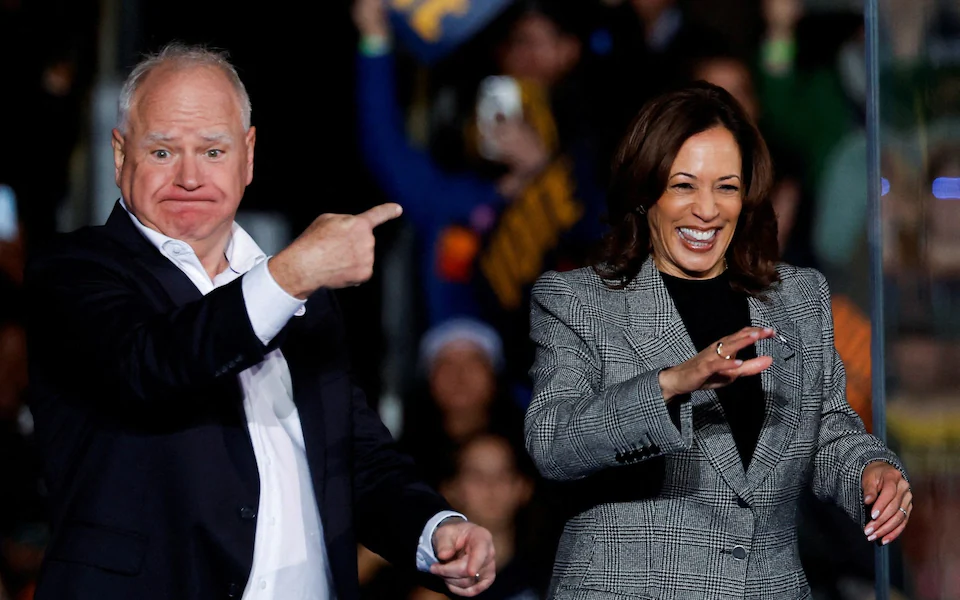The Democratic Party is in disarray as the blame game begins in the wake of Vice President Kamala Harris’s crushing election defeat to former President Donald Trump.
With Harris on the brink of losing the key swing states that determined the outcome of the 2024 election, party operatives and pundits are already pointing fingers at key decisions made during the campaign, most notably her choice of running mate.
Harris, 60, who had aimed to make history as the first woman and second Black president, struggled to gain traction with voters in the final stretch of the race.
As the results poured in early Wednesday, November 6 morning, it became clear that Harris was set to lose in nearly all seven critical swing states, including Pennsylvania, Georgia, and Arizona states that had been pivotal to the Democratic victory in 2020.
The Running Mate Controversy
One of the first targets of blame has been Harris’s selection of Minnesota Governor Tim Walz as her vice-presidential running mate.
Walz, a relatively low-profile figure who had served as a moderate governor of the state, was seen by many within the party as a safe choice. However, critics argue that the pick failed to energize key Democratic constituencies, particularly in swing states.
Lindy Li, a senior Democratic strategist based in Pennsylvania, questioned the decision, suggesting that the campaign could have fared better with a different pick.
“People are wondering tonight what would have happened if Harris had picked Josh Shapiro instead of Tim Walz,” Li told Fox News.
“Not only would it have helped in Pennsylvania, but Shapiro is a moderate who could have signaled to voters that Harris wasn’t the ‘San Francisco liberal’ that Trump painted her as.”
Shapiro, the popular and charismatic governor of Pennsylvania, had been seen as a strong alternative.
His appeal among moderates and working-class voters, especially in key battleground states, could have helped shore up Harris’s position, according to critics.
“Walz may have been too far to her left,” Li continued.
“In the eyes of the American people, Walz was the governor who oversaw the protests in Minneapolis, while Shapiro had a much broader appeal.”
The protests in Minnesota following the death of George Floyd had become a significant point of contention during the campaign, with Trump frequently attacking Harris and the Democrats for their handling of the unrest.
Policy Positions Under Scrutiny
Another major point of contention among Democratic insiders was Harris’s inability to differentiate herself from President Joe Biden, whose approval ratings were significantly underwater heading into Election Day.
Many analysts pointed to Harris’s failure to present a clear vision for her administration and to articulate how her policies would diverge from Biden’s.
One incident that has come under scrutiny was her appearance on The View, where Harris was asked what she would have done differently in the past four years under Biden’s leadership.
Her response “There is not a thing that comes to mind” was widely criticized as tone-deaf and out of touch with voters who were looking for leadership that could break with the past.
Democratic strategist James Carville expressed frustration with Harris’s lack of a distinct policy platform, calling it a “failure to stake out her own territory.”
Carville, a longtime party insider, said the campaign never fully capitalized on Harris’s unique background or experiences, and instead played it safe with bland talking points.
Blame for Voter Disengagement
Other prominent figures in the party, including MSNBC’s Joy Reid and CNN’s Van Jones, pointed to issues with voter outreach, particularly with white women voters in key swing states.
Reid blamed the loss of North Carolina on what she called a “failure to engage white women voters,” despite strong turnout from Black voters, who overwhelmingly supported Harris.
“In the end, they didn’t make their numbers,” Reid said, referring to white women in North Carolina who did not show up at the polls in the same numbers as in 2020. “Black voters came through for Harris, but white women voters did not.”
Jones, a CNN contributor and former adviser to President Barack Obama, criticized the Harris campaign’s emphasis on high-profile, celebrity-filled rallies. He argued that the events, featuring stars like Beyoncé and Taylor Swift, may have turned off working-class voters who struggled to find the time or resources to attend.
“I don’t think people understand. Working people sometimes have to choose—am I going to go to the big, cool concert and pay for babysitting for that, or am I going to figure out a way to get to the polls?” Jones said. “I don’t like these big star-studded events. They don’t resonate with the people who are going to decide the election.”
The Call for Listening to Voters
Symone Sanders, a former Harris campaign adviser who later became an MSNBC commentator, urged the party to listen to the concerns of voters.
“We have to listen to what the voters are saying,” Sanders said.
“The Democratic Party has to reckon with why so many of these key demographics were left behind or felt ignored.”
A Deeply Divided Democratic Party
As the fallout continues to unfold, the Democratic Party faces tough questions about its future direction and leadership. With Harris’s vice-presidential choice under scrutiny and the election loss still fresh, the party must confront its internal divisions and reassess how it can win back key swing voters in future elections.
For now, Democrats are left to grapple with the reality of what was expected to be a historic win turning into a dramatic defeat.
The tension surrounding the campaign’s missteps and strategic blunders will likely dominate the party’s post-election reflection, as figures like Shapiro, who were passed over in favor of Walz, begin to emerge as potential leaders for the future.
The coming weeks will be critical for Harris and her allies as they assess the full scope of their defeat and try to chart a path forward in a deeply polarised America.



